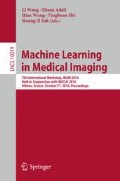Abstract
This paper proposes an unsupervised skin lesion segmentation method for dermoscopy images by exploiting the contextual information of skin image at the superpixel level. In particular, a Laplacian sparse coding is presented to evaluate the probabilities of the skin image pixels to delineate lesion border. Moreover, a new rule-based smoothing strategy is proposed as the lesion segmentation refinement procedure. Finally, a multi-scale superpixel segmentation of the skin image is provided to handle size variation of the lesion in order to improve the accuracy of the detected border. Experiments conducted on two datasets show the superiority of our proposed method over several state-of-the-art skin segmentation methods.
Access this chapter
Tax calculation will be finalised at checkout
Purchases are for personal use only
Notes
- 1.
m is the feature dimension.
- 2.
\(w_{ij}=exp\left( -\frac{\left\| y_{i},y_{j} \right\| }{\sigma ^{2}} \right) \quad s.t. \quad j\in NB\left( i \right) \).
- 3.
The parameter \(\beta \) is set to 0.2.
- 4.
References
Achanta, R., Shaji, A., Smith, K., Lucchi, A., Fua, P., Susstrunk, S.: Slic superpixels compared to state-of-the-art superpixel methods. IEEE Trans. Pattern Anal. Mach. Intell. 34(11), 2274–2282 (2012)
Ahn, E., Bi, L., Jung, Y.H., Kim, J., Li, C., Fulham, M., Feng, D.D.: Automated saliency-based lesion segmentation in dermoscopic images. In: 2015 37th Annual International Conference of the IEEE Engineering in Medicine and Biology Society (EMBC), pp. 3009–3012. IEEE (2015)
Alcón, J.F., Ciuhu, C., Ten Kate, W., Heinrich, A., Uzunbajakava, N., Krekels, G., Siem, D., De Haan, G.: Automatic imaging system with decision support for inspection of pigmented skin lesions and melanoma diagnosis. IEEE J. Sel. Top. Sig. Process. 3(1), 14–25 (2009)
Cavalcanti, P.G., Yari, Y., Scharcanski, J.: Pigmented skin lesion segmentation on macroscopic images. In: 2010 25th International Conference of Image and Vision Computing New Zealand (IVCNZ), pp. 1–7. IEEE (2010)
Das Gupta, M., Srinivasa, S., Antony, M., et al.: KL divergence based agglomerative clustering for automated vitiligo grading. In: Proceedings of the IEEE Conference on Computer Vision and Pattern Recognition, pp. 2700–2709 (2015)
Emre Celebi, M., Kingravi, H.A., Iyatomi, H., Alp Aslandogan, Y., Stoecker, W.V., Moss, R.H., Malters, J.M., Grichnik, J.M., Marghoob, A.A., Rabinovitz, H.S., et al.: Border detection in dermoscopy images using statistical region merging. Skin Res. Technol. 14(3), 347–353 (2008)
Erkol, B., Moss, R.H., Joe Stanley, R., Stoecker, W.V., Hvatum, E.: Automatic lesion boundary detection in dermoscopy images using gradient vector flow snakes. Skin Res. Technol. 11(1), 17–26 (2005)
Garnavi, R., Aldeen, M., Celebi, M.E., Varigos, G., Finch, S.: Border detection in dermoscopy images using hybrid thresholding on optimized color channels. Comput. Med. Imaging Graph. 35(2), 105–115 (2011)
Li, C., Kao, C.Y., Gore, J.C., Ding, Z.: Minimization of region-scalable fitting energy for image segmentation. IEEE Trans. Image Process. 17(10), 1940–1949 (2008)
Li, X., Li, Y., Shen, C., Dick, A., Van Den Hengel, A.: Contextual hypergraph modeling for salient object detection. In: Proceedings of the IEEE International Conference on Computer Vision, pp. 3328–3335 (2013)
Mendonça, T., Ferreira, P.M., Marques, J.S., Marcal, A.R., Rozeira, J.: PH 2-A dermoscopic image database for research and benchmarking. In: 2013 35th Annual International Conference of the IEEE Engineering in Medicine and Biology Society (EMBC), pp. 5437–5440. IEEE (2013)
Nascimento, J.C., Marques, J.S.: Adaptive snakes using the EM algorithm. IEEE Trans. Image Process. 14(11), 1678–1686 (2005)
Otsu, N.: A threshold selection method from gray-level histograms. Automatica 11(285–296), 23–27 (1975)
Ridler, T., Calvard, S.: Picture thresholding using an iterative selection method. IEEE Trans. Syst. Man Cybern. 8(8), 630–632 (1978)
Sezgin, M., et al.: Survey over image thresholding techniques and quantitative performance evaluation. J. Electron. Imaging 13(1), 146–168 (2004)
Silveira, M., Nascimento, J.C., Marques, J.S., Marçal, A.R., Mendonça, T., Yamauchi, S., Maeda, J., Rozeira, J.: Comparison of segmentation methods for melanoma diagnosis in dermoscopy images. IEEE J. Sel. Topics Sig. Process. 3(1), 35–45 (2009)
Society, A.C.: Cancer Facts & Figures 2015. American Cancer Society, Atlanta (2015)
Tong, N., Lu, H., Ruan, X., Yang, M.H.: Salient object detection via bootstrap learning. In: Proceedings of the IEEE Conference on Computer Vision and Pattern Recognition, pp. 1884–1892 (2015)
Tseng, P.: On accelerated proximal gradient methods for convex-concave optimization. submitted to SIAM J. J. Optim (2008)
Author information
Authors and Affiliations
Corresponding author
Editor information
Editors and Affiliations
Rights and permissions
Copyright information
© 2016 Springer International Publishing AG
About this paper
Cite this paper
Bozorgtabar, B., Abedini, M., Garnavi, R. (2016). Sparse Coding Based Skin Lesion Segmentation Using Dynamic Rule-Based Refinement. In: Wang, L., Adeli, E., Wang, Q., Shi, Y., Suk, HI. (eds) Machine Learning in Medical Imaging. MLMI 2016. Lecture Notes in Computer Science(), vol 10019. Springer, Cham. https://doi.org/10.1007/978-3-319-47157-0_31
Download citation
DOI: https://doi.org/10.1007/978-3-319-47157-0_31
Published:
Publisher Name: Springer, Cham
Print ISBN: 978-3-319-47156-3
Online ISBN: 978-3-319-47157-0
eBook Packages: Computer ScienceComputer Science (R0)

